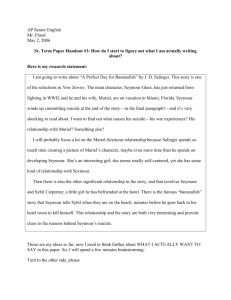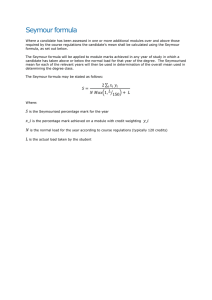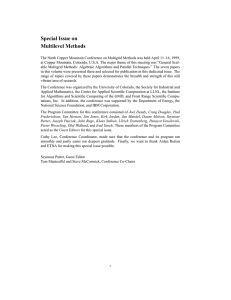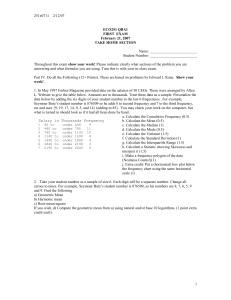Analysis of A Perfect Day for Bananafish
advertisement
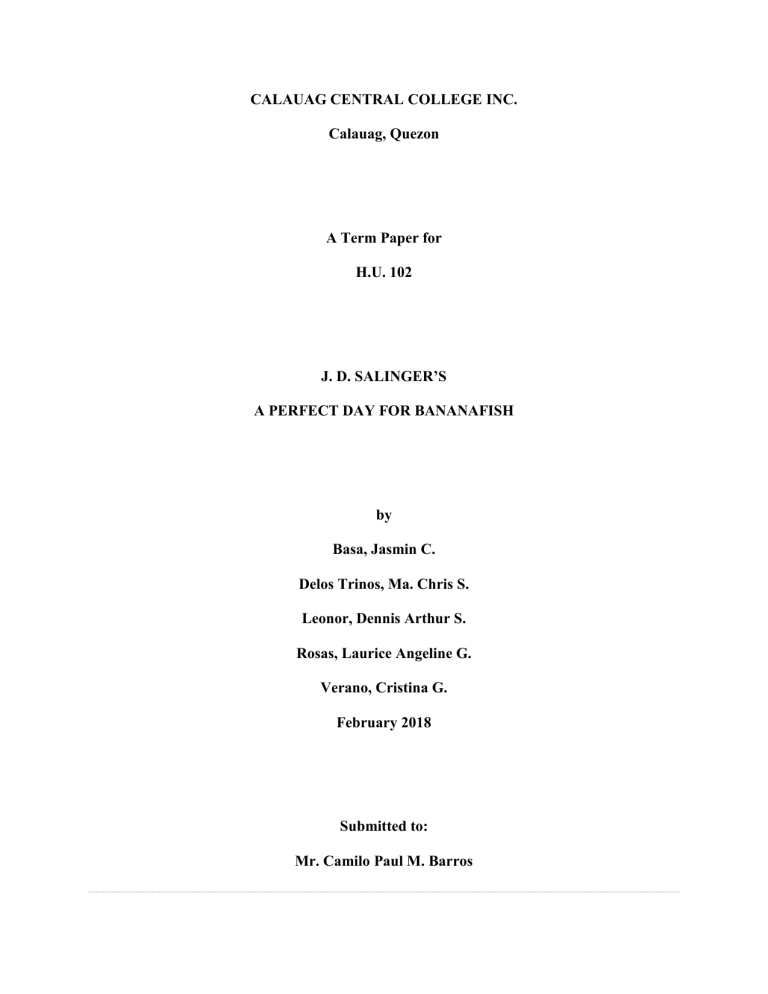
ANALYSIS OF “A PERFECT DAY FOR BANANAFISH” 0 CALAUAG CENTRAL COLLEGE INC. Calauag, Quezon A Term Paper for H.U. 102 J. D. SALINGER’S A PERFECT DAY FOR BANANAFISH by Basa, Jasmin C. Delos Trinos, Ma. Chris S. Leonor, Dennis Arthur S. Rosas, Laurice Angeline G. Verano, Cristina G. February 2018 Submitted to: Mr. Camilo Paul M. Barros ANALYSIS OF “A PERFECT DAY FOR BANANAFISH” 1 I. CONTEXT Brief Author Biography Jerome David (J. D.) Salinger is one of the most beloved and secretive American novelists of the twentieth century, as famous for being a recluse as he is for his fiction. Born in 1919 to a Jewish father and Irish-Catholic mother, Salinger spent his childhood in New York City, where he was part of the affluent social circles that he would later write about. Salinger attended the Valley Forge Military Academy and served in the army during World War II. After the war, he enrolled at Ursinus College in Pennsylvania and later took writing courses at Columbia University. Salinger began his literary career by writing short stories for magazines in the late 1940s. He admired and emulated the sparse prose style of Hemingway and Fitzgerald and, like Hemingway, wrote about darker aspects of human nature, death, and suicide. “A Perfect Day for Bananafish” appeared in theNew Yorker in 1948 and was later republished as the opening story in the collection Nine Stories (1953). In “A Perfect Day for Bananafish,” Salinger introduces the Glass family, who would become recurring characters in his fiction. In the next ten years, Salinger published three other Glass family stories in the New Yorker: “Franny,” “Zooey,” and “Raise High the Roof-Beam, Carpenters.” These stories appear in Salinger’s other books, which include Franny and Zooey(1961) and Raise the Roof Beam, Carpenters, and Seymour: An Introduction(1963). Critics revered Nine Stories, but Salinger’s other works were not so well received. The siblings of the Glass family were criticized for being unkind and obnoxious. Salinger’s first novel, Catcher in the Rye (1951), was the critical and popular success that launched Salinger into both literary fame and social scandal.Catcher quickly became an American classic, and its protagonist, Holden Caulfield, became the voice of a generation that ANALYSIS OF “A PERFECT DAY FOR BANANAFISH” 2 was coming of age in the postwar era. After the popular success and controversy of Catcher and the criticism of his subsequent works, Salinger isolated himself from the world, publishing little and maintaining a private life. Salinger wrote “Bananafish” in postwar America, when many veterans of World War II were struggling with the readjustment to civilian life. The story includes many of the elements that Salinger revisits throughout his career, including the idea of the outsider, male angst, critique of New York society, contempt for materialism, and the redemptive nature of children. Seymour Glass, like many of Salinger’s other protagonists, is an unhappy outsider, critiquing the society of which he is part. Salinger’s heroes are most like him in this regard—outsiders who are dissatisfied with society and therefore remove themselves from it by either self-seclusion (like Salinger himself) or suicide. Historical Context Through his writing, Salinger critiques his cultural environment—the United States in the post–World War II era. In “A Perfect Day for Bananafish,” Salinger critiques the materialistic consumer society of postwar America, which reveled in excess and gluttony. The country’s economic boom prompted people to buy things that they or their parents had never before been able to acquire. This prosperous period marked a drastic departure from the scarcity necessitated by the war and the Depression that preceded it. During this time, women were the target audience of marketing campaigns for products ranging from kitchen appliances to luxury clothes to magazines. For a returning solider like Salinger or Seymour who was coming home from a devastated Europe, this new American boom led to disorientation and unease. ANALYSIS OF “A PERFECT DAY FOR BANANAFISH” 3 Literary Context The criticisms conveyed in “A Perfect Day for Bananafish” would not become a mainstream movement for another ten years, and Salinger’s work fits into the larger artistic movement of postmodernism, which began in the 1960s. Postmodernist writers created works that were often minimalist in style, ambiguous in content, and heavily reliant on dialogue to convey meaning. The postmodern writing of Hemingway, Faulkner, and Salinger was the building block for the antiestablishment movement of the 1960s. The antiestablishment movement in literature, music, and society in general rejected the empty materialism of the postwar era and strived to regain a state of childlike innocence. Salinger’s influence on this movement can been seen in writers such as Jack Kerouac and Tom Wolfe, both of whom use outsider antiheros of dubious moral worth. II. PLOT OVERVIEW Exposition Muriel Glass waits in her Florida hotel room for the operator to put her call through to her mother. The hotel is full for a sales convention, so she must wait a long time. She fixes her clothing, paints her nails, and reads a magazine. When the call does go through, Muriel reassures her anxious mother about her safety. Her mother is concerned about the erratic, reckless behavior of Seymour, Muriel’s husband. She hints at a car accident that Seymour and Muriel were involved in and suggests that Seymour deliberately crashed Muriel’s father’s car into a tree. She reminds Muriel of the strange and rude things Seymour has said to members of Muriel’s family. Seymour has recently returned from the war, and Muriel’s mother believes that he was ANALYSIS OF “A PERFECT DAY FOR BANANAFISH” 4 discharged from the military hospital prematurely. Muriel is not as concerned as her mother. She is preoccupied by the fashion at the resort and the evening’s events. In the evenings, there are formal dinners and cocktail parties, at which Seymour often sits apart, playing the piano. The resort is full of society people, although Muriel feels that the quality of these people has diminished since the war. She tells her mother that Seymour is on the beach by himself. Rising Action On the beach, three-year-old Sybil Carpenter lets her mother put sunscreen on her body. Mrs. Carpenter then sends Sybil away so that she can go have cocktails. Sybil wanders far from the part of the beach where the hotel guests are situated. Eventually, she finds Seymour, who knows her. He tells her he likes her blue bathing suit, but her suit is yellow. Sybil accuses him of letting another little girl, Sharon Lipschutz, sit on the bench with him while he played the piano. Seymour assures Sybil that she is his favorite. Sybil tells Seymour he should push Sharon off the piano bench next time. As they get ready to go into the ocean, Seymour tells Sybil they should look for bananafish. They then discuss the tigers in one of Sybil’s children’s books, Black Sambo, as well as Sybil’s fondness for olives and wax. Sybil asks Seymour whether he likes Sharon Lipschutz, and Seymour tells her that he does, especially the fact that she is nice to small dogs and always kind. In the water, Seymour puts Sybil onto the raft and says it’s a perfect day for bananafish. He explains that these are normal-looking fish that swim into banana holes and greedily eat all the bananas inside. As a result, the bananafish become so fat that they cannot leave their holes and die. Doubtful of the fish at first, Sybil tells Seymour that she sees a bananafish with six bananas in his mouth. Seymour kisses the arch of Sybil’s foot. Sybil protests, and when they get out of the water, Sybil runs back to the hotel. ANALYSIS OF “A PERFECT DAY FOR BANANAFISH” 5 Climax Seymour, alone again, collects his things and returns to the resort. On his way to his room, he accuses a woman in the elevator of looking at his feet. When the woman denies it, Seymour becomes irate, calling her a “God-damned sneak.” The woman leaves the elevator. Falling Action Seymour proceeds to his room, where Muriel is napping. Sitting on the other bed, he watches her. Resolution Then he takes a gun from his luggage and shoots himself in the head. III. CHARACTER LIST Seymour Glass - A man who has recently returned from the war, where he suffered psychological trauma. A strange outsider, Seymour rejects the company of his wife, Muriel, and other adults at the Florida resort where he and Muriel are on vacation. He prefers to play with children at the resort and on the beach. He has an easy rapport with children and fully immerses himself in a childlike world of imagination when he is with them. When a child named Sybil claims she sees a bananafish, a creature that Seymour has invented, he kisses her foot. Seymour ultimately kills himself in the hotel. Character Analysis of Seymour Seymour is an unrepentant outsider among his wife, his wife’s family, the guests at the Florida resort, and society in general. Intelligent but psychologically damaged from the war, he has lost his footing in accepted adult society and renounces this society in favor of poetry, music, ANALYSIS OF “A PERFECT DAY FOR BANANAFISH” 6 and children. He is pale whereas the other guests are tan, and antisocial whereas the others enjoy mingling at cocktail parties and dinners. While Muriel socializes, Seymour plays the piano by himself or spends time with children at the beach. Always, he is apart from the crowd, moving through a world that is saturated more with yearned-for innocence than with adult realities. For much of the story, Seymour seems placid and quiet, a stark contrast to the unbalanced, erratic Seymour that Muriel and her mother discuss on the phone. His outsider status seems, if not “normal,” then at least harmless. However, when Seymour angrily accuses the woman in the elevator of looking at his feet, another side of him becomes clear. Ultimately, Seymour is unable to reconcile his outsider status with society and kills himself. Although Seymour’s interactions with children, particularly Sybil, are rooted in his desire for a return to innocence, modern readers may find it difficult to ignore the uncomfortable sexual undertones. On the surface, Seymour’s actions are harmless, even childlike. For example, he plays with Sybil and talks to her in a silly, childlike way, and he allows Sharon Lipschutz to sit with him on the piano bench, as though they are both children retreating from the adults in the room. However, Seymour also disrobes in front of Sybil, which he will not do in front of Muriel. He is a lone, adult man playing with a child not his own while her mother is not around, touching her physically as he lifts her onto a raft and kisses her foot. He also spins the tale of the bananafish, which seem blatantly phallic. Nothing comes of this talk, and Seymour’s struggle to achieve a kind of new innocence ultimately renders his words harmless. But as the scene on the beach is followed by his violent outburst in the elevator and then his suicide, his actions and words take on a darker, more adult character, unfair and inaccurate as that characterization may be. ANALYSIS OF “A PERFECT DAY FOR BANANAFISH” 7 Muriel Glass - Seymour’s pretty, socialite wife. Muriel is unconcerned with Seymour’s mental condition, although whether she is unconcerned because of indifference or deep love for him is never fully clear. Enamored with beauty and materialistic society, Muriel is firmly rooted in the materialistic world that Seymour rejects as well as in the adult world of womanhood and sexuality. In rejecting Muriel, Seymour rejects both society and adulthood. Character Analysis of Muriel Muriel, a pretty and self-interested socialite, is firmly entrenched in the superficial, materialistic world in which Seymour is an outsider. She places great importance on her appearance, spends time reading vapid magazines, and is concerned with the horrendous fashion she sees at the Florida resort. When Sybil asks Seymour where Muriel is, Seymour says, “She may be in one of a thousand places. At the hairdresser’s. Having her hair dyed mink.” Muriel elicits nothing but scorn from Seymour presumably since he came home from the war, although she is not overly concerned with his behavior, even his calling her “Miss Spiritual Tramp 1948.” Muriel’s unconcern suggests devotion to Seymour as well as indifference and naïveté. She willingly drove to Florida with him even after he crashed her father’s car, and she defends him against her mother’s wild, worried accusations. Though her mother criticizes Seymour’s erratic behavior, Muriel dismisses it and seems to accept that Seymour’s behavior is part of who he is. However, her unconcern also suggests that she is indifferent to Seymour’s mental health and well-being. Clearly, he has been psychologically damaged in the war, yet Muriel only halfheartedly pursues answers and information from a psychiatrist at the resort. She all but ignores Seymour during their trip, never pressuring him to make more effort to be social or trying to make him fit into social norms. Ultimately, her lack of concern reveals her naïveté. Seymour is and has been truly disturbed, but even at his moment of greatest crisis—when he takes the gun ANALYSIS OF “A PERFECT DAY FOR BANANAFISH” 8 from his luggage and shoots himself in the head—Muriel has no idea of the extent of Seymour’s distress. Her lack of concern may well have been a strange form of devotion, but it ultimately enabled Seymour to carry out his violent suicide. Sybil Carpenter - A young child vacationing with her mother. Sybil befriends Seymour on the beach and is able to understand him better than any other character, perhaps because her innocence has been untainted—unlike Seymour, she has not seen the ugliness of the world. However, Sybil is unnerved by Seymour when he kisses her foot in the ocean. Although Sybil is part of the childhood innocence Seymour would like to repossess, the kiss is an inappropriate gesture. Seymour has crossed a line, and Sybil runs away from him when they return to shore. Character Analysis of Sybil Young Sybil, like Seymour, is alone and misunderstood. Her mother misunderstands her chanting of Seymour Glass’s name as the nonsense words “see more glass,” which suggests that Sybil, too, lives in a world were no one understands her. With Seymour, however, she speaks freely and randomly, and Seymour listens intently and responds in kind. More important, she seems to understand Seymour in a way that adults cannot. She enters his imaginary world easily, willingly engaging in his silly talk and fantastical claims about bananafish. For a brief time, she and Seymour inhabit the same imaginary universe, creating life on their own terms, from their own minds. Sybil breaks the dream, protesting when Seymour kisses her foot. Although she is the child and Seymour is the adult, she is the one who is more willing to return to the real world, and when she runs from Seymour back to the hotel, she does so “without regret.” The name Sybil suggests an allusion to Greek mythology, in which sibyls are figures who can see the future. Sybil is a kind of seer because she is able to see the bananafish that Seymour describes. In some ways, she seems to be wise beyond her years, recognizing that Seymour needs ANALYSIS OF “A PERFECT DAY FOR BANANAFISH” 9 for her to “see” what he sees. Her ability to “see” the bananafish ultimately suggests her ability to understand Seymour. Her connection with him, however, cannot save his life, even though it granted him a final moment of happiness. Muriel’s Mother - A nosey socialite who is frantically concerned with Muriel’s safety around the erratic Seymour. Muriel’s mother reveals some of Seymour’s past transgressions, including strange, dangerous behavior and rude comments to family members, all of which suggest the extent of Seymour’s psychological distress. Mrs. Carpenter - Sybil’s mother. Preoccupied with drinking and gossiping, Mrs. Carpenter carelessly allows Sybil to play by herself on the beach, unaware that she is associating with a strange man. IV. THEMES, MOTIFS, AND SYMBOLS THEMES The Difficulty of True Communication Throughout “A Perfect Day for Bananafish,” characters struggle to communicate with one another, and each attempt is fraught with difficulty. Muriel and her mother engage in a haphazard conversation in which Muriel never really hears her mother’s worries and Muriel’s mother never really hears Muriel’s reassurances that she is fine. The two women talk at rather than with each other, and neither woman succeeds in truly communicating her thoughts to the other. When Muriel attempts to talk with the psychiatrist at the resort, their communication is hindered by the noise around them. Seymour is entirely unable to communicate with other people at the resort, preferring to sit alone playing the piano or spend time at the beach rather ANALYSIS OF “A PERFECT DAY FOR BANANAFISH” 10 than try to enter into a society in which he feels like an outsider. Sybil’s mother fails to communicate with Sybil clearly, believing that Sybil says “see more glass” when she is actually talking about Seymour Glass. Only Sybil and Seymour seem able to communicate effectively, although their discourse is on a child’s, not an adult’s, level. Though Muriel and Seymour do not speak with each other in the story, their communication is so fraught as to be nonexistent. Muriel has no idea what is really going on in Seymour’s mind, and Seymour seemingly has no desire to explain to her how he feels. The most tragic lack of communication is Muriel’s mistaken certainty that Seymour’s mental health is fine. Seymour’s violent suicide is, perhaps, the one truly successful act of adult communication in the story, the one gesture that cannot be misread or ignored. The Futile Search for Innocence Seymour hovers uncomfortably between the world of adult sexuality and world of childhood innocence. Scarred from his experiences in the war and suffering from psychological distress, Seymour finds refuge in children. Innocent and simple, they exist in a world that is free from adult suffering and greed. Unlike Muriel, who is fixated on appearances and class, Sybil can communicate with Seymour in a way that calms him. By speaking Sybil’s language, Seymour may hope to reconnect to or return to a childlike, innocent state. Children and their world seem to hold the possibility of redemption. A return to innocence proves to be impossible for Seymour. Though he is clearly distanced from Muriel emotionally, she is very much physically present. Their hotel room is suffused with the scents of her calfskin luggage and nail polish remover, and the physical space they share—in the car as they drove to Florida, in their hotel room, and at the resort—is small. Seymour’s self-isolation is temporary at best, as he opts out of parties to play the piano or ANALYSIS OF “A PERFECT DAY FOR BANANAFISH” 11 retreats to the beach. The world of childhood innocence has long been lost for Seymour, and he chooses suicide as an escape from the oppressive adult world in which he must otherwise live as an outsider. MOTIFS Materialism Salinger is critiquing the shallowness of materialism through Muriel and her world of wealth. Each time we see Muriel, she is luxuriating in wealth—she wears a white silk dressing gown, fixes her Saks blouse, meticulously paints her nails, and uses fine leather luggage. Seymour tells Sybil that Muriel may be getting her hair dyed “mink.” These suggestions of a luxurious lifestyle demonstrate the divide between Muriel and Seymour. She reads women’s magazines while Seymour reads poetry. She is more concerned with her clothes and the current fashion trends than with her husband’s emotional and psychological problems. Even when she and her mother are discussing Seymour’s erratic, dangerous behavior and unstable mental state, the talk keeps floating back to fashion and idle gossip. Muriel’s obsession with material goods alienates Seymour from Muriel and her world, just as Mrs. Carpenter’s indulgence in martinis and gossip shuts out Sybil. Seeing The idea of seeing permeates “A Perfect Day for Bananafish.” Seymour’s name sounds like “see more,” a confusion that Sybil’s mother falls prey to when Sybil talks to her about “see more glass.” Sybil’s name also references seeing; in Greek mythology, a sibyl was a seer. Seymour, or “see more,” suggests that Seymour is literally able to see more than other people. Because of his traumatic experiences in the war, he has a greater understanding of life and can recognize the materialism and superficiality of the world around him. Like Seymour, Sybil can ANALYSIS OF “A PERFECT DAY FOR BANANAFISH” 12 see what others cannot, though her openness is a function of her childishness rather than of trauma and regret. She easily sees the imaginary bananafish that Seymour tells her about and is therefore able to “see” Seymour in a way the adults in his life cannot. SYMBOLS Bananafish Bananafish, the imaginary creatures that gorge themselves on bananas and then die of banana fever, represent Seymour and his struggles to reengage with society after returning from the war. Seymour, an outsider in a world that seems to be guided by materialism, greed, and pettiness, has no real outlet for the complicated emotions he carries around inside him. He has been psychologically damaged by the war and, having been released early from the Army hospital, is clearly not getting the care he needs. Muriel and her family exist in a world he does not understand, and his behavior in that world is inappropriate, disturbing, and dangerous. His devotion to Sybil and other children reveals his heartbreaking yearning for innocence and clarity, feelings that have no outlet in the adult world. Just as the bananafish become too fat to leave their holes, Seymour is “fat” from the overflow of painful emotions he cannot express. At the end of the story, he, like the bananafish, dies. V. IMPORTANT QUOTATIONS EXPLAINED 1. “Did you see more glass?” “Pussycat, stop saying that. It’s driving Mommy absolutely crazy.” This exchange between Sybil and her mother, which appears about halfway through the story, is an example of how difficult clear communication is for the characters in the story. While Sybil is referring to Seymour Glass, Mrs. Carpenter hears “see more glass” and thinks Sybil is ANALYSIS OF “A PERFECT DAY FOR BANANAFISH” 13 being silly. Mother and daughter are speaking different languages—Seymour Glass is a figure who exists solely in Sybil’s world of childhood, whereas the phonetic interpretation, “see more glass,” is Mrs. Carpenter’s adult take on the phrase. This exchange also reveals Sybil as an outsider in her mother’s adult world, just as Seymour is. This exchange is markedly different from the conversations between Sybil and Seymour. Seymour, unlike Mrs. Carpenter, understands Sybil and is kind and patient with her—in a way, he speaks the language of childhood. 2. “If you want to look at my feet, say so,” said the young man. “But don’t be a Goddamned sneak about it.” As Seymour returns to his room at the end of the story, he accuses a woman in the elevator of looking at his feet. When she denies this claim, he becomes irate. This unfounded anger illustrates two parts of Seymour’s character. First, such a violent and unprovoked outburst shows that he really is mentally unstable. While Muriel has spoken with her mother about Seymour’s psychological condition, this is the only direct evidence in the story that Seymour is in fact not well. Second, Seymour is angry with the woman for being a “sneak”—that is, for being inauthentic. This is a criticism against the materialistic world of the hotel, where appearances rule. Shortly after this exchange, Seymour commits suicide, and in a way, this outburst is an attempt to have one final interaction or communication with the adult world. His effort is inappropriate and disturbing, but its violence reveals the extent of Seymour’s psychological distress. 3. Then he went over sat down on the unoccupied bed, looked at the girl, aimed the pistol, and fired a bullet through his right temple. ANALYSIS OF “A PERFECT DAY FOR BANANAFISH” 14 The final sentences of the story demonstrate Salinger’s control of language to create tone and tension. These short phrases portray Seymour’s actions as calm and matter-of-fact—there is no room for doubt or hesitation in the abrupt phrases. Tension builds as the actions pile up, and until the last moment, there is some ambiguity about whom Seymour will shoot—this may be the crazy act that Muriel’s mother worried Seymour would perpetrate. Instead, Seymour shoots himself, ending his life and the story at the same time. The suicide is so sudden, and at first Seymour’s reasons for doing it seem wholly unclear—he seems unhappy and cut off from the world, yes, but his afternoon on the beach with Sybil did little to suggest that this was to come. However, the story can be read as a slow, simmering buildup of actions and problems, which makes Seymour’s suicide shocking but not necessarily a surprise.
